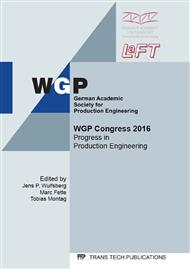[1]
H.S. Kim, S.W. Park, H.Y. Hwang, D.G. Lee: Effect of the smart cure cycle on the performance of the co-cured aluminum/composite hybrid shaft, Composite Structures, Volume 75, Issues 1–4, September 2006, pp.276-288.
DOI: 10.1016/j.compstruct.2006.04.030
Google Scholar
[2]
R. Matsuzaki, M. Shibata, A. Todoroki: Improving performance of GFRP/aluminum single lap joints using bolted/co-cured hybrid method, Composites Part A: Applied Science and Manufacturing, Volume 39, Issue 2, February 2008, pp.154-163.
DOI: 10.1016/j.compositesa.2007.11.009
Google Scholar
[3]
S. Ucsnik, M. Scheerer, S. Zaremba, D.H. Pahr: Experimental investigation of a novel hybrid metal–composite joining technology, Comp. Part A: Appl Sci and Manuf, 41: 3 (2010), p.369–374.
DOI: 10.1016/j.compositesa.2009.11.003
Google Scholar
[4]
S.V. Hoa, A. Di Maria, D. Feldman: Inserts for Fastening Sheet Molding Compounds; in: Composite Structures, Issue 8; pp.293-309 (1987).
DOI: 10.1016/0263-8223(87)90021-3
Google Scholar
[5]
F. Schievenbusch: Beitrag zu hochbelasteten Krafteinleitungselementen für Faserverbundbauteile, Dissertation Technischen Universität Chemnitz (2003).
Google Scholar
[6]
E. Schmachtenberg, M. Schuck, I. Kuehnert: Assembly injection moulding: forming and assembly in one process, Kunststoffe International (2007).
Google Scholar
[7]
M. Honkanen, M. Hoikkanen, M. Vippola, J. Vuorinen, J., T. Lepist: Metal–plastic adhesion in injection-molded hybrids, J Adhes Sci Technol, 34, p.1747–1761 (2009).
DOI: 10.1163/016942409x12489445844435
Google Scholar
[8]
H. Paul, M. Luke, F. Henning: Combining mechanical interlocking, force fit and direct adhesion in polymer–metal-hybrid structures, Comp. Part B: Eng., Vo. 73, pp.158-165 (2015).
DOI: 10.1016/j.compositesb.2014.12.013
Google Scholar
[9]
W.A. Hufenbach, F. Lenz, S. Spitzer, O. Renner: Welle-Nabe-Verbindungen für Leichtbauantriebswellen in Faserverbund-Metall-Mischbauweise, VDI-Berichte Nr. 2176, pp.141-153 (2012).
DOI: 10.51202/9783181023372-257
Google Scholar
[10]
F. Möller, C. Thomy, F. Vollertsen, P. Schiebel, C. Hoffmeister, A. S. Herrmann: Novel method for joining CFRP to aluminium. Lane 2010, Physics Procedia, pp.37-45.
DOI: 10.1016/j.phpro.2010.08.027
Google Scholar
[11]
A. Modler: Intrinsic lightweight steel-composite hybrids for structural components, Materials Science Forum Vols. 825-826, pp.401-408 (2015).
DOI: 10.4028/www.scientific.net/msf.825-826.401
Google Scholar
[12]
R.C. Alderliesten: On the available relevant approaches for fatigue crack propagation prediction in Glare, International Journal of Fatigue, Volume 29, Issue 2, February 2007, p.289–304 (2007).
DOI: 10.1016/j.ijfatigue.2006.03.003
Google Scholar
[13]
P. Woizeschke et al.: Joining of aluminum and CFRP parts using titanium foils as transition elements, Euro Hybrid – Materials and Structures 2014 – Proceedings, pp.69-75 (2014).
Google Scholar
[14]
C. Schmidt, O. Deniz, K. Voeltzer, P. Weber: Self-Configurable Production of CFRP Aerospace Components Based on Multi-Criteria Structural Optimization, CFK-Valley Convention Stade (2015).
Google Scholar
[15]
K. Masania, R. Geissberger, D. Stefaniak, C. Dransfeld: Steel Foil Reinforced Composites: Study of Strength, Plasticity and Ply Size Effects. 20th Int. Conf. Compos. Mater. ICCM-20, Copenhagen (2015).
DOI: 10.1016/j.matdes.2020.109302
Google Scholar
[16]
D. Stefaniak, B. Kolesnikov, C. Hühne: Improving the mechanical performance of unidirectional CFRP by metal-hybridization. 15th Europ. Conf. on Comp. Mat., Venice, June (2012).
Google Scholar
[17]
A. Fink: Lokale Metall-Hybridisierung zur Effizienzsteigerung von Hochlastfügestellen in Faserverbundstrukturen. Doctoral Thesis, Technische Universität Braunschweig (2010).
Google Scholar
[18]
J. Gebhardt, F. Pottmeyer, J. Fleischer, K. Weidenmann: Characterization of metal inserts embedded in carbon fiber reinforced plastics, 20th Symposium on Composites, July 1 - 3, 2015, Vienna, Austria, Trans Tech Publ, Pfaffikon, S. 506–513 (2015).
DOI: 10.4028/www.scientific.net/msf.825-826.506
Google Scholar
[19]
F. Ballier; J. Schwennen; J. Berkmann; J. Fleischer: The Hybrid RTM Process Chain: Automated Insertion of Load Introducing Elements during Subpreform Assembling, Applied Mechanics and Materials, Vol. 794, pp.312-319 (2015).
DOI: 10.4028/www.scientific.net/amm.794.312
Google Scholar
[20]
J. Fleischer, S. -F. Koch, P. Ruhland: Rotational Molding of Fiber Reinforced Plastics with Elastic Composite Core. CIRP COMA Conference 2016, Proceedings, South Africa, pp.181-186.
Google Scholar
[21]
C. Garthaus et al.: Tape braiding: high performance fibre-reinforced thermoplastic profile structures, JEC COMPOSITES Magazine. Vol. 69 2015, 4 (2015).
Google Scholar


